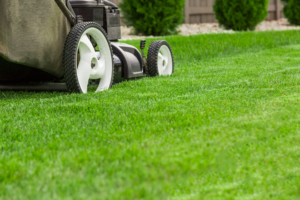Longmont, CO – – – When brown spots, or signs of stress appear on lawns, many people overreact by watering more. The Rocky Mountain Sod Growers urge against this practice. It wastes water and overlooks the real cause of the problem.
If your lawn looks brown or stressed, you should check to find out what’s really going on.
Before increasing watering times, do the screwdriver test to make sure the soil really is dry. If the screwdriver may be easily pushed into the soil you don’t need more water now. Water-logged soil can damage the lawn more than letting it get too dry. If you have difficulty pushing the screwdriver into the soil it may be too dry.
 Brown patches may indicate a sprinkler problem that’s keeping water from reaching those areas. Check your system thoroughly and identify areas for hand-watering if needed. Don’t run your whole irrigation system longer trying to get more water to those areas. Check spray areas and adjust if needed.
Brown patches may indicate a sprinkler problem that’s keeping water from reaching those areas. Check your system thoroughly and identify areas for hand-watering if needed. Don’t run your whole irrigation system longer trying to get more water to those areas. Check spray areas and adjust if needed.
If your lawn is stressed, the color begins to turn blueish-gray before it looks like straw. If you walk across it and can see footprints 30 minutes later, it’s stressed.
Instead of increasing water times, consider watering a second time a bit later. This is called cycle and soak. It gives water enough time to soak in between watering times and helps to ensure that excess water doesn’t run off and isn’t wasted.
When temperatures cool, or we are receiving enough water from Mother Nature, cut back on the watering times.
Always remember the following tips to have a great lawn and conserve water at the same time.
- Water between 10:00 p.m. and 6:00 a.m. to avoid water loss through evaporation.
- Mow the lawn a little higher – If you mow at 3 inches or higher this will allow the soil to retain more moisture and avoid heat stress.
- Don’t waste water by overwatering – remember that grass doesn’t waste water – people do.
For more information on new sod or care for existing lawns, visit www.sod-growers.com.
# # #

